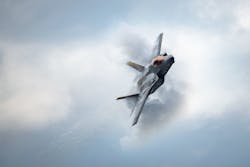U.S. military updates legacy systems as it eyes sixth-generation future
NASHUA, N.H. - The U.S. Department of Defense (DOD) is utilizing technological advances to keep legacy aircraft viable in the 21st century as the military rolls out fifth-generation fighters and takes steps to break ground on the sixth gen.
This March, the United States Air Force officially accepted the first F-15EX at Elgin Air Force Base in Florida. The USAF plans to acquire 144 of the aircraft from Boeing to replace its F-15C/D models, which have an average age of 37 years.
“This is a big moment for the Air Force,” said Col. Sean Dorey, F-15EX program manager with the Air Force Life Cycle Management Center’s Fighters and Advanced Aircraft Directorate, responsible for the acquisition, modernization and sustainment of the aircraft. “With its large weapons capacity, digital backbone, and open architecture, the F-15EX will be a key element of our tactical fighter fleet and complement 5th-generation assets. In addition, it’s capable of carrying hypersonic weapons, giving it a niche role in future near-peer conflicts.”
Lockheed Martin's fifth-gen F-35 Lightning II was given new warfighting capabilities as part of a collaboration between Lockheed, Northrop Grumman, and BAE Systems.
Northrop Grumman's ICNI system provides F-35 pilots with more than 27 fully-integrated operational functions. Using its industry-leading software-defined radio technology, Northrop Grumman's design allows the simultaneous operation of multiple critical functions while greatly reducing size, weight and power demands on the advanced F-35 fighter. These functions include Identification Friend or Foe (IFF), automatic acquisition of fly-to points, and various voice and data communications such as the Multifunction Advanced Data Link (MADL).
The BAE Systems' AN/ASQ-239 system is an advanced, proven electronic warfare suite that provides fully integrated radar warning, targeting support, and self-protection to detect and defeat threats and enable the F-35 to reach well-defended targets.
This spring, Lockheed Martin's Skunk Works, the Missile Defense Agency, and the USAF announced that a U-2, five F-35s, and an F-22 were able to demonstrate fifth-generation to fifth-gen communications abilities across domains as the aircraft provided real-time data to operators on the ground.
Named Project Hydra, the latest flight test leveraged an Open Systems Gateway (OSG) payload aboard the U-2 to connect an F-22 to five F-35s via native Intra-Flight Data Link (IFDL) and Multifunction Advanced Data Link (MADL), successfully sharing data between all airborne aircraft and with nodes on the ground. The target tracks were also transmitted by and through the U-2 into the fighter avionics and pilot displays.
“Project Hydra marks the first time that bi-directional communications were established between 5th Generation aircraft in-flight while also sharing operational and sensor data down to ground operators for real-time capability,” said Jeff Babione, vice president and general manager, Lockheed Martin Skunk Works. “This next-level connectivity reduces the data-to-decision timeline from minutes to seconds, which is critical in fighting today's adversaries and advanced threats.”
The Project Hydra effort also marked the first time F-35 sensor data was delivered to an operational ground system over a Tactical Targeting Network Terminal (TTNT) link using an airborne gateway. This data was then sent to the US Army Integrated Battle Command System (IBCS) Airborne Sensor Adaptation Kit (A-Kit), also developed by Lockheed Martin. The A-Kit then transmitted data to the IBCS Tactical System Integration Laboratory (TSIL) at Fort Bliss, Texas. IBCS used the F-35 sensor data to conduct a simulated Army fires exercise.
Northrop Grumman, Lockheed Martin's Skunk Works, and Boeing's Phantom Works are among the companies currently hard at work putting together a prototype for sixth-generation planes.
The Air Force has not decided yet on a platform or set of technologies yet is moving beyond the conceptual realm and into the exploration of weapons, sensors, networking, and other technologies.
The Air Force is making progress with its sixth-generation aircraft initiative, called Next Generation Air Dominance (NGAD). It had been largely conceptual for years, but Air Force officials now say current prototyping and demonstrations are informing which avionics and other technologies the service will invest in for the future.
Senior Air Force officials have said that an analysis of alternatives has been completed and that work on requirements is in progress. Work includes various modeling and efforts to explore crucial hardware and software for onboard computers.
About the Author
Jamie Whitney
Senior Editor
Jamie Whitney joined the staff of Military & Aerospace Electronics in 2018 and oversees editorial content and produces news and features for Military & Aerospace Electronics, attends industry events, produces Webcasts, and oversees print production of Military & Aerospace Electronics.
